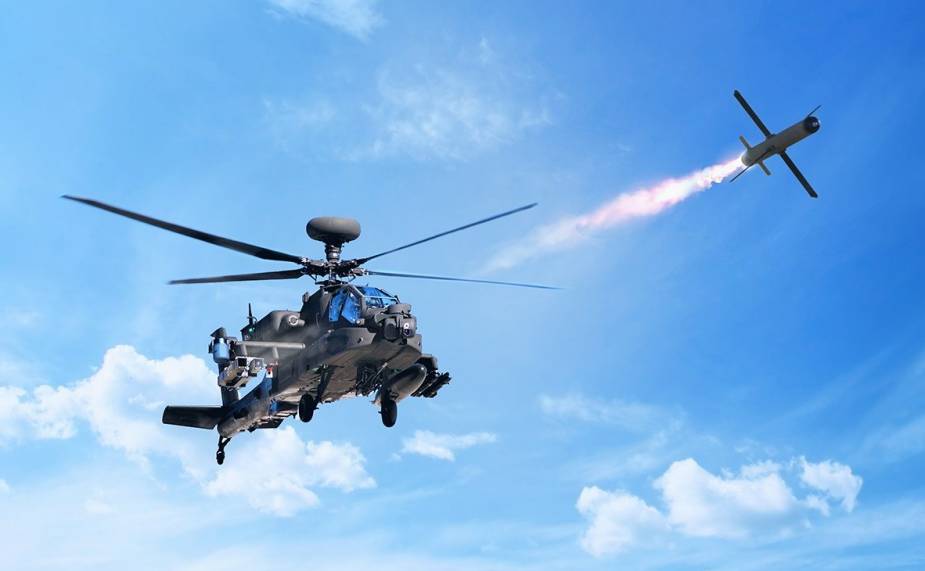Breaking news
Lockheed Martin live fire demo proves integration of Spike NLOS missile on AH-64E Apache.
The Precision Strike team successfully fired two Spike NLOS all-up rounds (AURs) from the AH-64E V6 Apache on January 26, 2023, at Yuma Proving Ground in Arizona. The successful live fire event verifies the Spike NLOS Long Range Precision Munitions Directed Requirement (LRPM DR) system’s integration onto the Apache platform and allows it to enter qualification testing.
Follow Air Recognition on Google News at this link
 In this composite image, Spike NLOS launches from a U.S Army AH-64E Apache attack helicopter (Picture source: Lockheed Martin)
In this composite image, Spike NLOS launches from a U.S Army AH-64E Apache attack helicopter (Picture source: Lockheed Martin)
"The successful integration of Spike NLOS on the Apache platform demonstrates Lockheed Martin's continued commitment to 21st century security solutions that help our customers complete their missions,” says Tom Bargnesi, program management senior manager of the Precision Strike team at Lockheed Martin Missiles and Fire Control. “The system’s expansion onto additional platforms, along with its mission-focused defense capabilities, ensures it will help the U.S. Army stay ahead of ready in an ever-evolving threat environment.”
The demonstration featured two Spike NLOS AURs firing from an Apache platform at a stationary target in two separate scenarios. The Spike NLOS system will begin testing to qualify the design for airworthiness release (AWR). Once AWR is awarded, the system will be fielded on the U.S. Army’s Apache Echo Model V6 platforms by September 2024.
To transform into a multi-domain force by 2035, the U.S. Army plans to modernize their future helicopter fleet with a Long Range Precision Munition (LRPM), allowing pilots to engage threats from safe stand-off ranges.
While defining their final requirements for an LRPM program of record, the Army has named Spike Non-Line of Sight (NLOS) as the interim LRPM solution and will evaluate the system on U.S. Army AH-64E Apache helicopters. Lockheed Martin is teamed with Rafael Advanced Defense Systems, Ltd., the original manufacturer of the Spike NLOS missile, to provide the weapon for U.S. applications and to install the system onto the Apache platforms.
The U.S. Army will conduct a shoot-off later this year with selected vendors, including Lockheed Martin, to inform the LRPM requirements. Eventually, the LRPM program of record will be fielded on the Army’s Future Attack Reconnaissance Aircraft (FARA).
Integration of Spike NLOS missile on Apache enables time-sensitive attacks
“Today, with a 32-kilometer range, Spike NLOS can conduct precision engagement from a safe stand-off distance,” Senior Program Manager Tom Bargnesi said. “This, combined with the weapon’s electro-optical, imaging infrared seeker and man-in-the-loop control, makes Spike NLOS a true long-range precision munition.”
The interim LRPM contract award came after Lockheed Martin supported two Army Aviation demonstrations – one in August 2019 and again in February 2021. For both events, Spike NLOS launched from Apache AH-64E helicopters and successfully engaged its targets. During the most recent firing, Spike NLOS prosecuted a stationary maritime target, positioned 32 kilometers away.
“Not only can Spike NLOS impact targets without line-of-sight, but its advanced rocket motor ensures the missile system approaches the target quickly, enabling time-sensitive strikes,” Bargnesi said. “This is critical in combat operations when every second matters.”
Lockheed Martin first partnered with Rafael in 2012 to bring Spike NLOS’s unique capabilities to U.S. customers. The missile’s long-range and “Non-Line of Sight” capabilities offer significant complements to the current lethal solutions of Army aviation platforms. Its man-in-the-loop control allows the user to “guide” the missile to its target while receiving real-time video so soldiers can make critical targeting decisions, or even abort the mission, while the missile is still in flight. This also provides users with an in-flight awareness of the battlefield, even within GPS-denied environments.
Spike NLOS is integrated on a variety of ground, aviation, and maritime platforms, providing a stand-off capability to strike distant or geographically concealed targets outside of the direct line of sight.


























